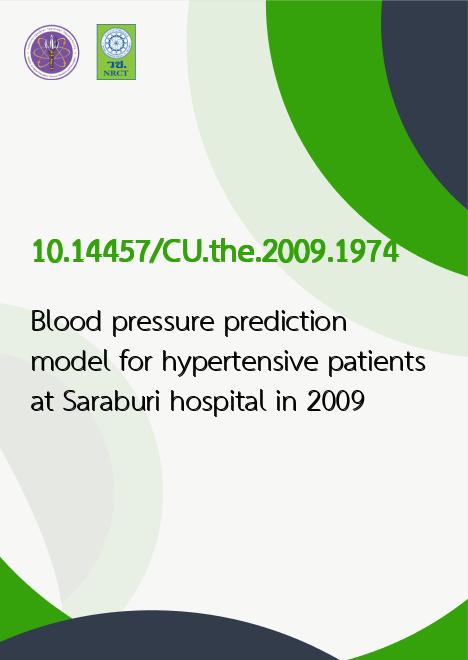
|
Blood pressure prediction model for hypertensive patients at Saraburi hospital in 2009 |
|---|---|
| รหัสดีโอไอ | |
| Title | Blood pressure prediction model for hypertensive patients at Saraburi hospital in 2009 |
| Creator | Anongnart Siemmai |
| Contributor | Titinun Auamnoy |
| Publisher | Chulalongkorn University |
| Publication Year | 2552 |
| Keyword | Blood pressure, Hypertension, Hypertension -- Exercise therapy |
| Abstract | The objectives of this study were to (1) Compare means of calories burnt by exercise, medication compliance, eating behavior score, knowledge about hypertension, age and blood pressure between gender. (2) Find correlations between calories burnt by exercise, medication compliance, eating behavior score, knowledge about hypertension, age and blood pressure. (3) Estimate hierarchical stepwise multiple regression analysis (MRA) model to predict blood pressure. A retrospective research by face to face interview and accessing clinical data were employed to investigate relationship between health behavior factors namely—calories burnt by exercise, medication compliance, eating behavior score, demographic data and blood pressure of 200 hypertensive patients at Saraburi hospital 2009, randomly generated by computer. This study found that total sample size of 200 (100%) hypertensive patients, mostly 118 (59%) were female, 82 (41%) were male with average age 55.21 ± 12.01 years, average calories burnt per week 2787.24 ± 141.61, average medication compliance score 7.41 ± 1.93, average eating behavior score 6.33 ± 1.14 average Systolic blood pressure 150.24 ± 18.49 and average Diastolic blood pressure 89.40 ± 9.15. Cronbach’s Alpha coefficient of Sorofman’s Compliance scale for constructs “right time” and “right amount” were 0.7978 and 0.7896 respectively and Auamnoy Eating Behavior Scale was 0.7915. One Way ANOVA confirmed that blood pressure, medication compliance, knowledge about hypertension, age and calories burnt by exercise between male and female were not significantly different (p > 0.05). But eating behavior score between male and female were significantly different (p = 0.05). Pearson’s product moment correlation confirmed that age and eating behavior score were significantly positively correlated with Systolic blood pressure (r =*+0.16, **+0.59, R² = 0.03, 0.35 with p = 0.02, 0.00 respectively). Calories burnt by exercise and medication compliance were significantly negatively correlated with Systolic blood pressure (r = **-0.81, **-0.98, R² = 0.66, 0.96 with p = 0.00, 0.00 respectively). Correlation confirmed that age, calories burnt by exercise and medication compliance significantly inversely related with Diastolic blood pressure (r = **-0.19, **-0.43, **-0.60, R² = 0.04, 0.18, 0.36 with p = 0.00, 0.00, 0.00 respectively) but eating behavior score significantly related with Diastolic blood pressure (r =**+0.53, R² = 0.28 with p = 0.00). Hierarchical stepwise multiple regression analysis estimated the prediction equations. The three most significant variables those predicted Systolic blood pressure and Diastolic blood pressure were: medication compliance (Beta = -0.90,-0.70), eating behavior score (Beta = 0.82, 0.72) and calories burnt by exercise (Beta = -0.11, -0.29) P = 0.00, 0.00, 0.00 R² = 0.58, 0.55) respectively. Conclusion: eating behavior, calories burnt by exercise and medication compliance were three significantly most influence factors for predicting blood pressure. |
| URL Website | cuir.car.chula.ac.th |